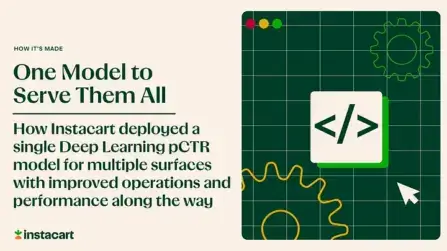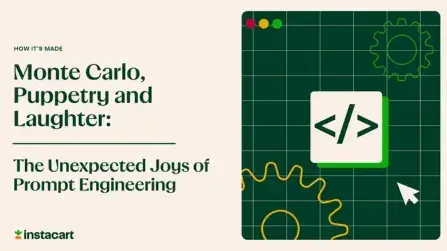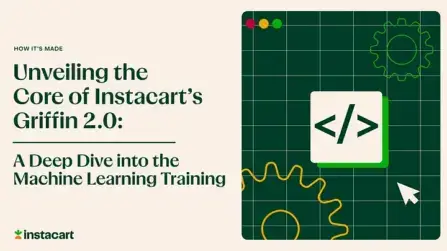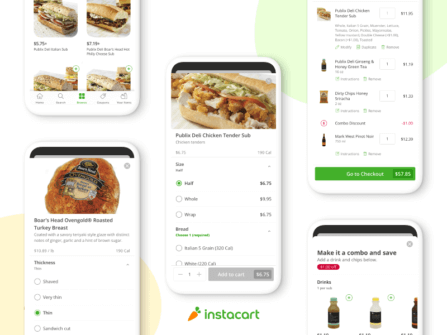How It's Made
Making Groceries More Accessible with Research
A Q&A with Elizabeth Ferrall-Nunge, Instacart’s Head of Research.
We just welcomed Elizabeth Ferrall-Nunge to Instacart Design as our new Head of Research. Elizabeth comes to us from Twitter, where she led the company’s research team, and Google before that, where she was a UX Researcher on Google Maps. At Instacart, she’ll scale the research team that gets to the heart of what busy families, dedicated shoppers, retailers and advertisers want from our products and our brand.
Research at Instacart has a direct and meaningful impact on our mission to create a world where everyone has access to the food they love and more time to enjoy it together. Elizabeth and the expanded research team aim to ground every strategic decision, product roadmap, engineering build, UX design, and creative brief in real-world insights gathered from across our four-sided marketplace.

You’ve got a long career in user research. Can you give us a bit of background on how you got to where you are now?
I was lucky enough to spend the first part of my career at Google, honing my research fundamentals while working alongside many of the groundbreaking researchers who defined the field of User Experience. During that time I learned how to conduct field research, surveys, eye tracking, RITE studies, and logs analysis (among other methods) across a range of audiences and platforms on Geo products.
After 5 years, I was itching to go somewhere smaller and joined Twitter as one of its early researchers. Working alongside my manager, I helped scale the team and eventually moved into a management role, taking on more scope until I was promoted to lead all of Research. During a period of slowed growth and attrition, I focused on rebuilding the team while shifting Research into a strategic role across Twitter’s core consumer, revenue, and data products. This insights-led shift (via Jobs to Be Done) completely changed our strategy, leading to a greater focus on customers and ultimately helped to reaccelerate growth. Google is where I learned how to become an effective researcher and Twitter is where I learned how to become an impactful leader.
I’ve always attempted to learn from those around me and incorporate their strengths into my own approach, both in research and leadership. Over the years, I’ve become comfortable with the differences that make my approach unique, and place more value on being authentic to myself and my own style of leadership. During my interview, I felt that Instacart would be a place where I could be myself, and this was a key driver in my decision to join.
When did you first use Instacart?
I first tried Instacart in 2016 when I moved to a new neighborhood that didn’t have a grocery store within walking distance. Without a car available, I started using Instacart to help with grocery shopping.
When I moved out of the city, I was lucky enough to have several grocery stories within a 10 minute walk. However, one of my favorite grocery stores, Berkeley Bowl, is insanely crowded with long lines on the weekends. When the most convenient time to get groceries is during off hours or in the middle of the week, Instacart allows me to get my favorite foods from my favorite grocer while I’m working.
What made you make the jump to Instacart?
Underlying most of my decisions is a desire to learn and challenge myself. I’m a big believer in running towards things that are unfamiliar and hard. With Google, I had the opportunity to learn about wayfinding, geo products, and mobile navigation. With Twitter, I delved deeply into social media, ads, abuse and misinformation, and international markets. And with Instacart, I’m excited to learn about food access and equity, and four sided marketplaces.
When looking for my next stop after Twitter, I wanted to find a mission driven company tackling a durable problem space, whose leadership team had values aligned with my own — integrity, rigor, curiosity, and fun.
On top of that, Instacart’s mission, “giving everyone access to groceries,” got me really excited and I couldn’t stop thinking about all the ways in which research could help realize that vision. Who has access right now and who doesn’t? How has grocery shopping changed in the age of COVID-19? How do we balance the needs of customers with shoppers? How can we make Instacart more accessible?
After interviewing with the team, did anything surprise you?
Oh, absolutely. During my interviews, the team opened my eyes to how complex the online grocery industry really is. Here are a few areas that stood out to me:
- Demographics — Instacart’s shopper community generally skews female, especially when compared to other on-demand companies. Unlike services where others are getting into your car, Instacart provides an alternative that is perceived to be safer by our shopper community, according to research. Additionally, our shoppers are motivated by helping those who can’t get to the store.
- Enterprise — I was surprised to discover the breadth of Instacart’s Enterprise product line — it’s an entire e-commerce ecosystem. Hundreds of retailers have partnered with Instacart to digitize their catalogs, build online storefronts, or offer delivery or pickup services. By having multiple offerings vs. a one size fits all approach, Instacart tailors its services to meet the needs of customers and grocery stores.
- Community partnerships — Instacart recently partnered with Local Market (a grocer who, last December, ended a six year food desert in South Side, Chicago), to ensure community members have an option for grocery delivery (Learn more here). This partnership helps provide food access and equity to vulnerable populations amidst COVID-19 stay-at-home orders, and is an example of the kind of work which really gets me excited about Instacart’s mission.
What qualities do you look for in a researcher?
Being a great researcher is so much more than understanding how to do research — it’s about identifying and asking critical questions, creating empathy in others through compelling insights, influencing decision makers, and coming up with creative solutions — all under the constraints of running a business. Outside of technical rigor and business acumen, I look for curiosity, creativity, passion, humility, grit, and storytelling ability. These are the intangibles that separate a solid researcher from a game-changer for their team and company.
It’s month one. Now that you’re settling in, what project are you going to tackle first?
The most pressing question on my mind has been: How will society and grocery shopping change long-term, given the massive shifts in consumer behavior in the wake of COVID-19?
In other words, what recently adopted behaviors will become permanent and what impact will they have on the future of grocery shopping? What does this mean for people from different socioeconomic groups, some of whom may not be able to access on-demand marketplaces? While these questions are outstanding across industries, it’s particularly critical for something as fundamental as access to food.
Lastly, what’s always in your cart ?
Topo Chico, bananas, chocolate bars, eggs, and lemons!
Interested in learning more about Design at Instacart? Head over to our Design blog.
Want to work with Elizabeth? We’re hiring! Check out our careers page to see our current Design Team openings.
Most Recent in How It's Made

How It's Made
One Model to Serve Them All: How Instacart deployed a single Deep Learning pCTR model for multiple surfaces with improved operations and performance along the way
Authors: Cheng Jia, Peng Qi, Joseph Haraldson, Adway Dhillon, Qiao Jiang, Sharath Rao Introduction Instacart Ads and Ranking Models At Instacart Ads, our focus lies in delivering the utmost relevance in advertisements to our customers, facilitating novel product discovery and enhancing…
Dec 19, 2023
How It's Made
Monte Carlo, Puppetry and Laughter: The Unexpected Joys of Prompt Engineering
Author: Ben Bader The universe of the current Large Language Models (LLMs) engineering is electrifying, to say the least. The industry has been on fire with change since the launch of ChatGPT in November of…
Dec 19, 2023
How It's Made
Unveiling the Core of Instacart’s Griffin 2.0: A Deep Dive into the Machine Learning Training Platform
Authors: Han Li, Sahil Khanna, Jocelyn De La Rosa, Moping Dou, Sharad Gupta, Chenyang Yu and Rajpal Paryani Background About a year ago, we introduced the first version of Griffin, Instacart’s first ML Platform, detailing its development and support for end-to-end ML in…
Nov 22, 2023

 Building Instacart Meals
Building Instacart Meals  Introducing Coil: Kotlin-first Image Loading on Android
Introducing Coil: Kotlin-first Image Loading on Android  7 steps to get started with large-scale labeling
7 steps to get started with large-scale labeling 
